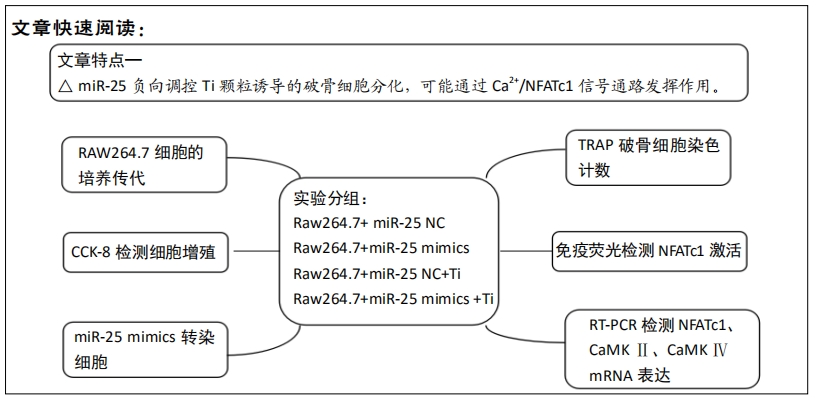[1] JONAS K, NILS W, ALEXANDER D, et al. The etiology of revision total hip arthroplasty: current trends in a retrospective survey of 3450 cases. Arch Orthop Trauma Surg. 2020;140(9):1265-1273.
[2] KHATOD M, CAFRI G, INACIO MC, et al. Revision Total Hip Arthoplasty: Factors Associated with Re-Revision Surgery. J Bone Joint Surg Am. 2015;97(5):359-366.
[3] KENNEY C, DICK S, LEA J, et al. A systematic review of the causes of failure of Revision Total Hip Arthroplasty. J Orthop. 2019;16(5):393-395.
[4] SUNDFELDT M, CARLSSON LV, JOHANSSON CB, et al. Aseptic loosening, not only a question of wear: a review of different theories. Acta Orthop. 2006;77(2):177-197.
[5] GOODMAN SB, GALLO J, GIBON E, et al. Diagnosis and management of implant debris-associated inflammation. Expert Rev Med Devices. 2020;17(1):41-56.
[6] NEGISHI-KOGA T, TAKAYANAGI H. Ca2+-NFATc1 signaling is an essential axis of osteoclast differentiation. Immunol Rev. 2009;231(1):241-56.
[7] Ha M, Kim VN. Regulation of microRNA biogenesis. Nat Rev Mol Cell Biol. 2014;15(8):509-524.
[8] ONO K, HORIE T, NISHINO T, et al. MicroRNAs and High-Density Lipoprotein Cholesterol Metabolism. Int Heart J. 2015;56(4):365-371.
[9] DIRKX E, GLADKA MM, PHILIPPEN LE, et al. Nfat and miR-25 cooperate to reactivate the transcription factor Hand2 in heart failure. Nat Cell Biol. 2013;15(11):1282-1293.
[10] YAO Y, SUN WD, SUN QF, et al. Platelet-Derived Exosomal MicroRNA-25-3p Inhibits Coronary Vascular Endothelial Cell Inflammation Through Adam10 via the NF-κB Signaling Pathway in ApoE Mice. Front Immunol. 2019;10(1):2205.
[11] ZHANG JF, SHI LL, ZHANG L, et al. MicroRNA-25 Negatively Regulates Cerebral Ischemia/Reperfusion Injury-Induced Cell Apoptosis Through Fas/FasL Pathway. J Mol Neurosci. 2016;58(4):507-516.
[12] Mehlich D, Garbicz F, Włodarski PK. The emerging roles of the polycistronic miR-106b~25 cluster in cancer - A comprehensive review. Biomed Pharmacother. 2018;107(1):1183-1195.
[13] HUANG YZ, REN KY, YAO T, et al. MicroRNA-25-3p regulates osteoclasts through nuclear factor I X.Biochem Biophys Res Commun. 2020;522(1): 74-80.
[14] LIU XQ, QU XH, WU Cl, et al. The effect of enoxacin on osteoclastogenesis and reduction of titanium particle-induced osteolysis via suppression of JNK signaling pathway. Biomaterials. 2014;35(22):5721-5230.
[15] ZHANG YY, LIN Y, XIAO LL, et al. The effects of icariine concentration on osteoclasts bone resorption induced by titanium particles in vitro. Regen Biomater. 2015;2(3):197-202.
[16] LEE SS, WOO CH, CHANG JD, et al. Roles of Rac and cytosolic phospholipase A2 in the intracellular signalling in response to titanium particles. Cell Signal. 2003;15(3):339-345.
[17] HOLT G, MURNAGHAN C, REILLY J, et al. The biology of aseptic osteolysis. Clin Orthop Relat Res. 2007;460(1):240-252.
[18] TANAKA S, NAKAMURA K, TAKAHASI N, et al. Role of RANKL in physiological and pathological bone resorption and therapeutics targeting the RANKL-RANK signaling system. Immunol Rev. 2005; 208(1):30-49.
[19] FURUYA Y, MORI K, NINOMIYA T, et al. Increased bone mass in mice after single injection of anti-receptor activator of nuclear factor-kappaB ligand-neutralizing antibody: evidence for bone anabolic effect of parathyroid hormone in mice with few osteoclasts. J Biol Chem. 2011;286(42):37023-37031.
[20] YAMAKAWA Y, TAZAWA H, HASEI J, et al. Role of zoledronic acid in oncolytic virotherapy: Promotion of antitumor effect and prevention of bone destruction. Cancer Sci. 2017;108(9):1870-1880.
[21] CHAVARRY NGM, PERRONE D, FARIAS MLF, et al. Alendronate improves bone density and type I collagen accumulation but increases the amount of pentosidine in the healing dental alveolus of ovariectomized rabbits. Bone. 2019;120(1):9-19.
[22] SON A, KANG N, OH SY, et al. Homer2 and Homer3 modulate RANKL-induced NFATc1 signaling in osteoclastogenesis and bone metabolism. J Endocrinol. 2019;242(3):241-249.
[23] SONG MK, PARK C, LEE YD, et al. Gα12 regulates osteoclastogenesis by modulating NFATc1 expression. J Cell Mol Med. 2018;22(2):849-860.
[24] KROL J, LOEDIGE I, FILIPOWICZ W. The widespread regulation of microRNA biogenesis, function and decay. Nat Rev Genet. 2010;11(9): 597-610.
[25] CONG C, TIAN J, GAO T, et al. lncRNA GAS5 Is Upregulated in Osteoporosis and Downregulates miR-21 to Promote Apoptosis of Osteoclasts. Clin Interv Aging. 2020;15(1):1163-1169.
[26] MOUSSA FM, COOK BP, SONDAG GR, et al. The role of miR-150 regulates bone cell differentiation and function. Bone. 2020; undefined:115470.
[27] GAASCH JA, BOLWAHNN AB, LINDSEY JS. Hepatocyte growth factor-regulated genes in differentiated RAW 264.7 osteoclast and undifferentiated cells. Gene. 2006;369(1):142-152.
[28] LEE SS, WOO CH, CHANG JD, et al. Roles of Rac and cytosolic phospholipase A2 in the intracellular signalling in response to titanium particles. Cell Signal. 2003;15(3):339-345.
[29] KANG JY, KANG N, YANG YM, et al. The Role of Ca-NFATc1 Signaling and Its Modulation on Osteoclastogenesis. Int J Mol Sci. 2020;21(10):3646.
[30] TAKAYANAGI H, KIM S, KOGA T, et al. Induction and activation of the transcription factor NFATc1 (NFAT2) integrate RANKL signaling in terminal differentiation of osteoclasts. Dev Cell. 2002;3(6):889-901.
[31] LIU FX, ZHU ZN, MAO YQ, et al. Inhibition of titanium particle-induced osteoclastogenesis through inactivation of NFATc1 by VIVIT peptide. Biomaterials. 2009;30(9):1756-1762.
[32] DA COSTA MARTINS PA, SALIC K, GLADKA MM, et al. MicroRNA-199b targets the nuclear kinase Dyrk1a in an auto-amplification loop promoting calcineurin/NFAT signalling. Nat Cell Biol. 2010;12(12): 1220-1227.
[33] SATO K, SUEMATSU A, NAKASHIMA T, et al. Regulation of osteoclast differentiation and function by the CaMK-CREB pathway. Nat Med. 2006;12(12):1410-1416.
[34] CHANG EJ, HA J, HUANG H, et al. The JNK-dependent CaMK pathway restrains the reversion of committed cells during osteoclast differentiation. J Cell Sci. 2008;121(15):2555-2564.
[35] PAN L, HUANG BJ, MA XE, et al. MiR-25 protects cardiomyocytes against oxidative damage by targeting the mitochondrial calcium uniporter. Int J Mol Sci. 2015;16(3):5420-5433.
|







